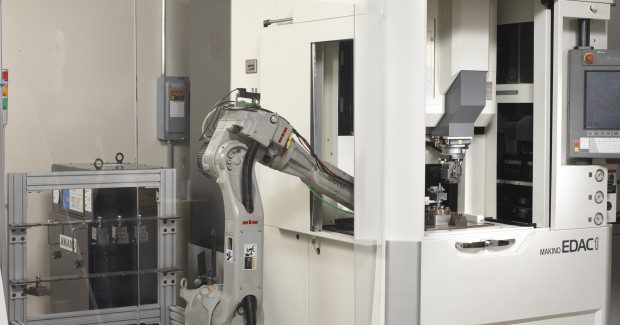Now is the Time to Automate Your Die/Mold Systems
Increasing demands for shorter lead times, improved quality and lower costs mean shop managers should seriously consider automation as an investment in long-term dynamic growth and flexibility.
Posted: October 3, 2015
The adoption of automated technologies and processing methods is no longer a solution limited to production machine shops. Today mold, tool and die shop owners from across North America are increasingly turning to automated machining technologies to achieve dramatic improvements in quality, reliability and productivity that directly impact bottom-line growth and overall competitiveness.
Advancements in automated technologies have expanded considerably over the last decade to accommodate high-mix production demands that are ideal for mold, tool and die machining processes. Complex and sophisticated material handling cells can be designed for a wide variety of applications, including hard milling, graphite milling, 5-axis machining, and sinker and wire EDM. The net result is consistent performance and improved efficiencies across all processes through the elimination of manual setups and stack-up error.
Moreover, the automation of mold, tool and die processes support companies in optimizing labor resources by removing non-value-added labor practices and empowering companies to redeploy labor into more value-added roles that focus on business growth, not just getting the work done. Automation enables shops to more effectively compete globally by reducing workpiece costs while expanding the business pipeline.
Despite the initial upfront costs of adopting automation, mold, tool and die shops can expect automation to deliver a rapid return on investment (ROI), oftentimes paying for itself in as quickly as one to two years. With these numerous opportunities for business growth, it’s time for shop managers to seriously consider automation as an investment in long-term dynamic growth and flexibility.
THREE WAYS AUTOMATION TRANSFORMS BUSINESS
Many mold, tool and die shops today face increasing demands for shorter lead times, improved quality and lower costs. Automation offers several key advantages for overcoming these challenges:
Compressing Lead Times:
Implementing automation provides dramatic reductions in lead times and improved flexibility in production schedules. By decoupling setup processes from machining processes, automation maximizes machine utilization from an average of 30 percent to 35 percent on standalone machines to as much as 85 percent within an automated cell. Mold, tool and die shops operating automated systems are generally more flexible in their production schedules, including the ability to accommodate quick turnaround completion of urgent engineering changes without disrupting current processes in progress. This flexibility is ideal for mold, tool and die shops that need to shift rapidly within a high product-mix environment. Moreover, the ability to perform lights-out processing opens up additional machining time to produce more workpieces during off-hours, particularly long cycle-time applications.
Improving Quality:
By automating work loading/unloading and reducing the number of setups for processing, mold, tool and die shops that use automation benefit from greater accuracy, quality and consistency. This capability eliminates several of the most common sources for deviation, including human error and stack-up error. Additionally, many automated systems are designed with in-process error-prevention technologies, such as coordinate-measure machines, tool-length measurement and fixture, workpiece or tool probing. When engineered successfully, closed-loop feedback can be introduced into a cell for the highest degree of quality and confidence.
Reducing Costs:
Among customers’ primary concerns, cost remains highly influential in their decision of who to contract work out to. Automation is one of the most powerful means for reducing costs of the production of molds, tools and dies. With fewer setups, elimination of manual loading and unloading, less secondary handwork and the ability for one operator to manage multiple machines simultaneously, automated machining systems enable shops to significantly reduce costs associated with non-value-added labor time. This approach also relieves stress and the costs associated with identifying the additional skilled labor resources necessary to grow capacity. Shorter lead times and improved scheduling flexibility provide greater throughput and opportunities to improve workflow efficiency and reduce on-hand inventory. Cost reductions can be realized with faster ROI of capital equipment and the ability to extend operating hours through unattended operation.
MAKING THE MOVE TO AUTOMATION
There has never been a more critical time to consider automating mold, tool and die manufacturing operations. As more shops adopt automated technologies, those currently running stand-alone machines are likely not going to be able to match the speed, quality and costs expected from customers. Making the move to automation should not be taken lightly, however. Designing, engineering and implementing an automated machining cell is a complex process that should be performed with the support of experienced engineering partners and equipment providers. This buy-in is essential to ensure the effectiveness and long-term reliability of any investment in automation.
Mold, tool and die shops that are pursuing automation must find suppliers that have dedicated themselves to delivering the knowledge and experience to support their goals. From simple robot load/ unload cells to complex multi-machine and closed-loop processing cells, dedicated suppliers can provide the engineering support and well-qualified third-party supplier partnerships that are necessary to guarantee long-term competitiveness in the mold, tool and die industries.



















